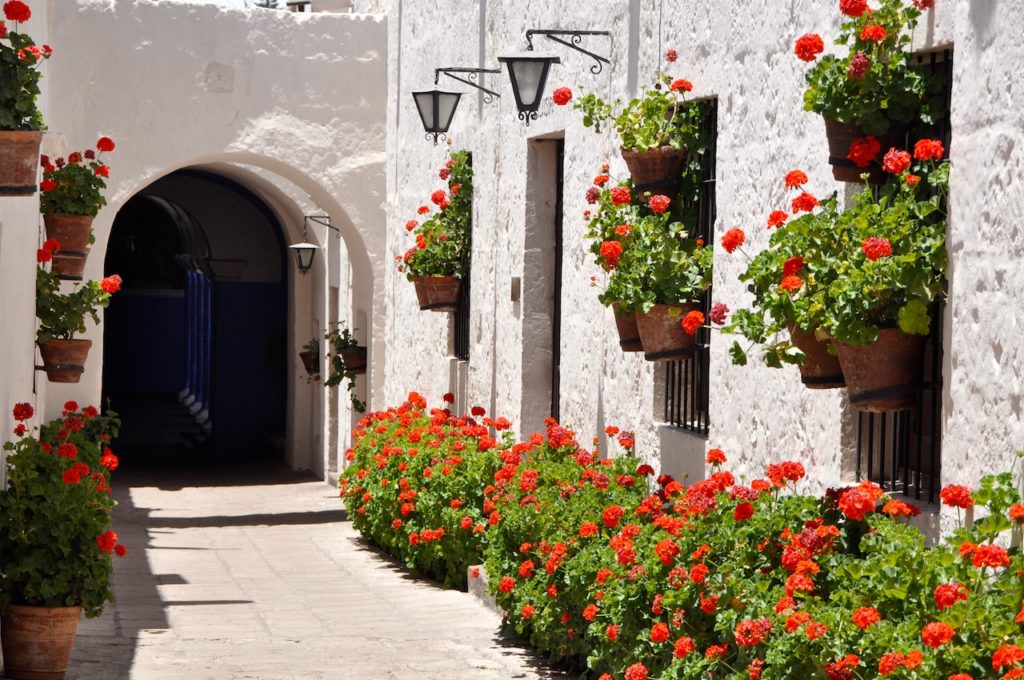
Cordova Street, Saint Catalina Monastery.
The legendary Santa Catalina Monastery in the White City of Araquipa was the next stop on our Dragoman truck trip. This meant mysterious Nazca lines and sand-boarding fun on dunes in the Valley of Las Trancas was now committed to photographs and memories.
Of Interest – Araquipa (the colonial capital of Peru) sits at the foot of the active El Misti volcano. The city oozes the best of Spanish colonial charm and has three 3 volcanos lurking around it’s perimeter. All buildings (baroque style) have been built from sillar, a white volcanic stone – giving it the nickname o“The White City”.
Table of Contents
Santa Catalina Monastery – “a city within a city”.
This amazing monastery is a small village, with narrow cobblestone streets, alleyways lined with bright red geraniums, plants, charming plazas, fountains, chapels, secret niches and quiet corners.
At every corner you see buildings vividly painted in orange, blue and red meaning it’s truly a photographer’s paradise.
The atmosphere is so inviting that you feel like practicing to be a nun and taking up residency for a few weeks!
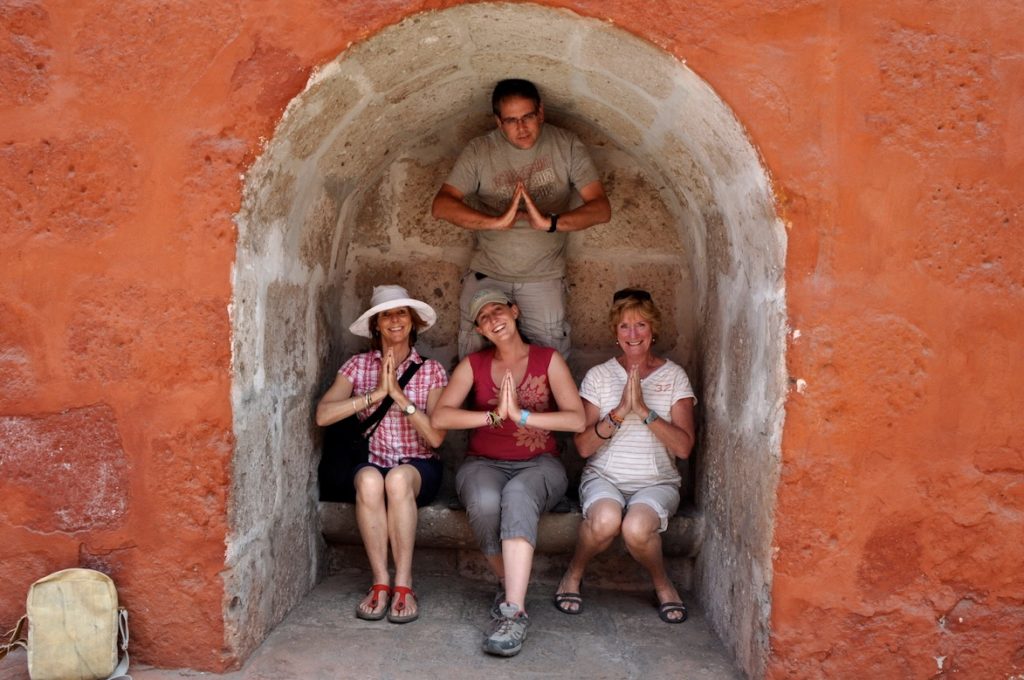
Practicing to be accepted into the Monastery for a holiday.
To give you an idea of size – this mini city is 20,000 square metres and takes up an entire block in Araquipa. There are 3 cloisters, 6 streets, 80 housing units, an art gallery, and a cemetery. The entire complex has been operated by nuns for the past four centuries.
This means it should technically be called a “Convent” because it’s managed by nuns – however, the name Santa Catalina Monastery has stuck throughout Arequipa’s history. Maybe something to do with gender inequality in the old days?
Now, this isn’t just “another monastery” – it’s like no other in the world. If you don’t see anything else in Araquipa this must be on your list.
From our hotel we wandered down to the impressive Plaza de Armas Square and got our first sight of the vast outer walls of the “city within a city”.
We visited mid morning which is a beautiful way to enjoy the monastery with its colorful painted walls set against the clear blue sky of Arequipa. But if you’re more of a night owl, two nights a week you can explore the grounds by candlelight and revisit the life of a nun as it was centuries ago.
Local guides are on hand at the entrance and are fluent in English, Spanish, French, German, Italian, Portuguese and Japanese. For the Santa Catalina monastery they are worth their weight in gold because they offer so much local knowledge that isn’t included in a brochure. Cost is S/.20 (Peruvian Sol), approximately $8 AUD.
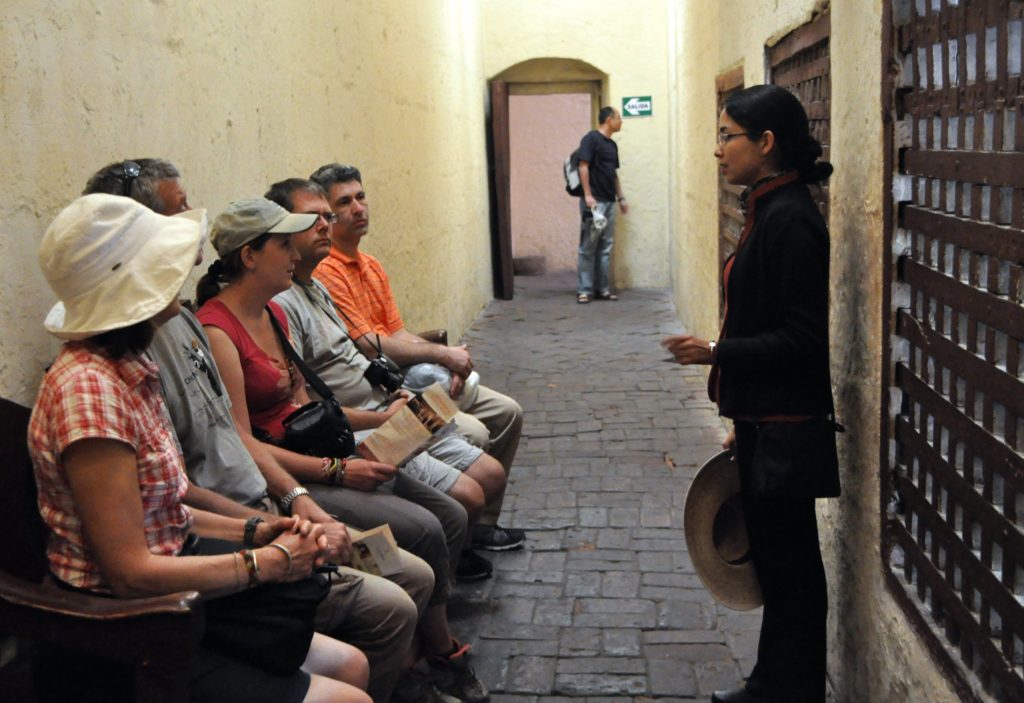
Hire a guide for local knowledge
(Note the guide fee is on top of the entry fee of S/.35 ($14 AUD)
Our tour lasted about an hour, and then more, knowing more about the layout of the complex we continued to explore ever nook and cranny with the use of the brochure. (Given as part of the entrance fee).
The three main closers are very interesting. To start, you pass under the Silence Arch and enter the Novice Cloister. You can’t miss this as it’s built around a large courtyard with a rubber tree in the middle.
After passing under this arch, novice nuns had to zip their lips in a vow of solemn silence and resolve to a life of work and prayer. A tough gig and no-one in our group would have lasted for more than two minutes!
Graduated novices passed onto the Orange Cloister, named for the orange trees growing in the centre that represent eternal life.
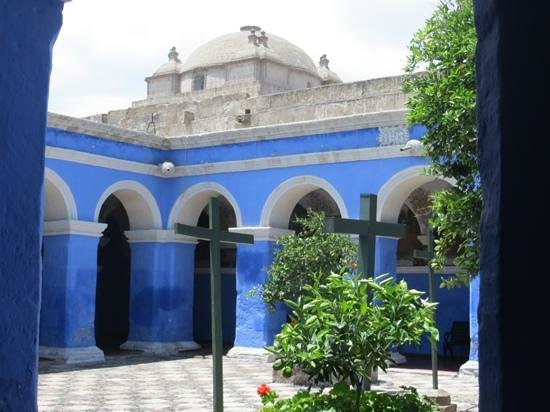
The Orange Cloister
This cloister lets you peek into the Profundis Room – a mortuary where dead nuns were mourned along with lots of paintings of the deceased (and morbid looking) nuns lining the walls. The artists were only given 24 hours to complete the posthumous paintings because they couldn’t pre-paint them while the nuns were still alive
Then there’s the Main Cloister which is the largest and has a covered walkway into the convent. Apart from private confessionals, there are 32 religious paintings on display which were used as learning material by the novice nuns. Nine of these historic paintings show the life of Jesus and the remaining 23 are dedicated to the life of the Virgin Mary – these were amazing.
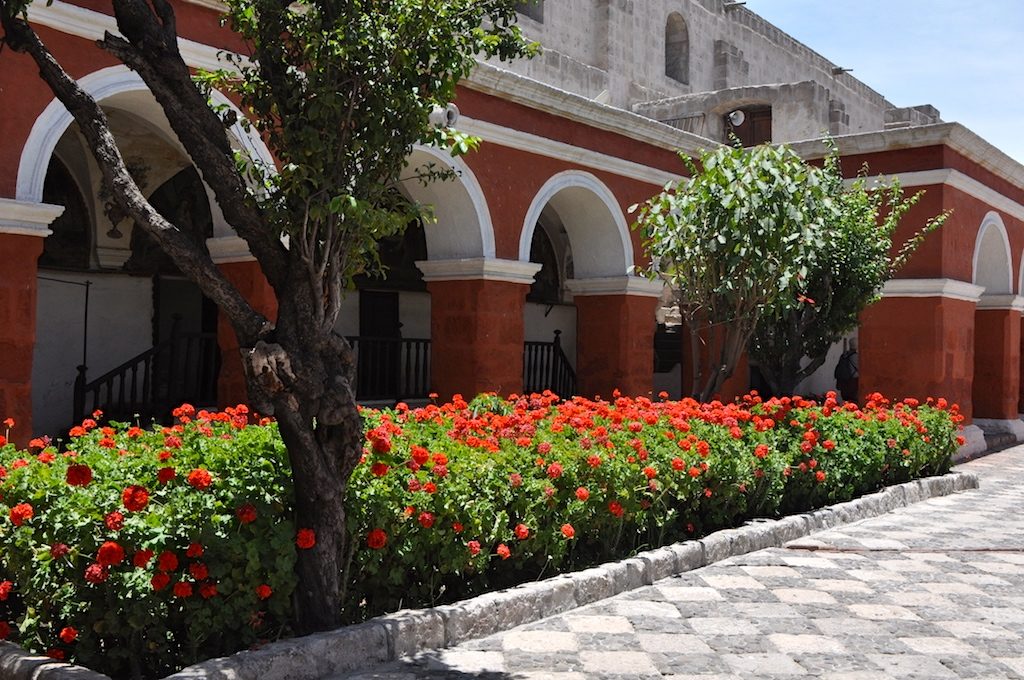
Main Cloister bordered by red geraniums.
A stroll along the picturesque Córdova Street, lined with bright red geraniums, will show the cell like rooms that were the nuns’ living quarters. Interestingly enough, depending on the wealth of the nuns, the furnishings ranged from very basic to lavish! Not quite the one model fits all that was expected.
Lastly we came across the Great Cloister of the Santa Catalina Monastery that is bordered by the chapel on one side and the art gallery, used as a communal dormitory, on the other. This building takes on the shape of a cross.
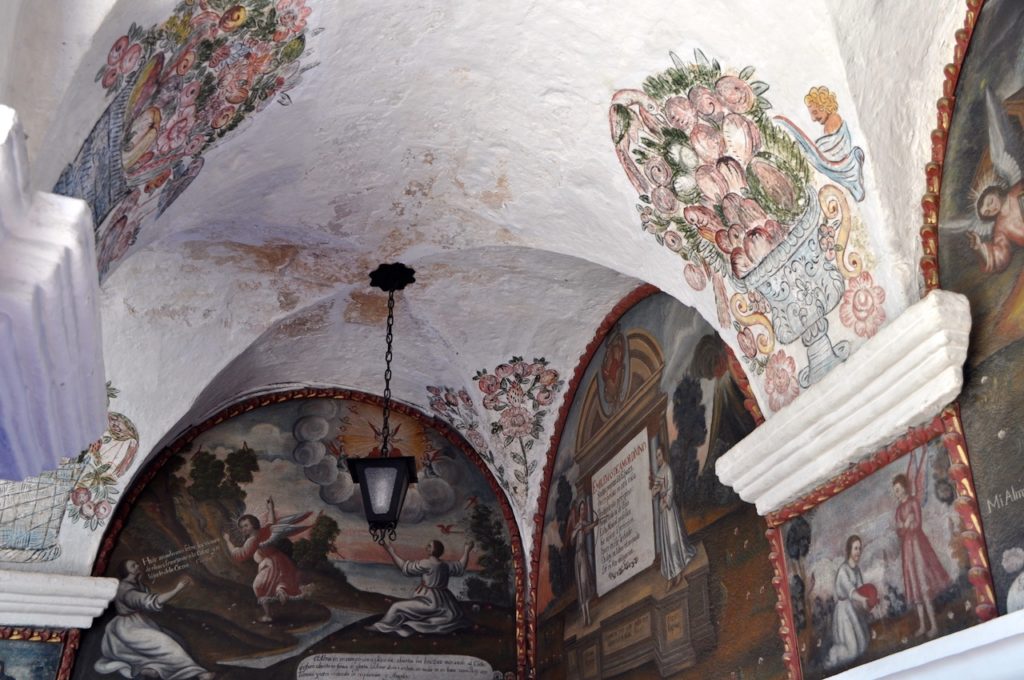
Great Cloister featuring historic religious artwork
Interesting fact:
The nuns at the Santa Catalina Monastery are still cloister nuns, meaning that they don’t see outsiders. At the moment, the oldest nun in the monastery is 100 years old and there are a total of 20 nuns.
Finally hunger pangs arrived and a walk down past eh burnt orange walls of Toledo street led us to a delightful cafe. On offer were delicious coffee and freshly cooked pastries which we enjoyed in a peaceful garden setting. And…although I wouldn’t tell the whole world his… I saw the menu offered nips of Galliano in coffee for a few extra Sols. So, after much thought I added one to my coffee ….what a delicious drop it was!
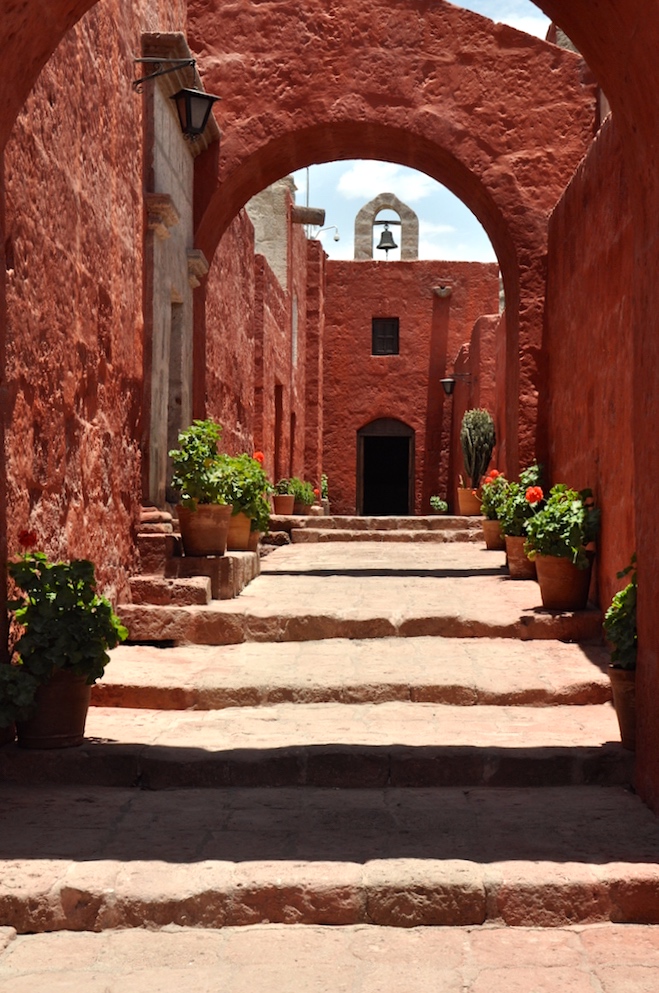
Toledo Street with its colourful orange walls in the Santa Catalina Monastery.
Convent Laundry
After our café relaxation we came to the convent laundry communal washing area where servants used washed in the mountain runoff that was channeled into huge earthenware jars.
What an clever set up this was!
Built in 1770, it has 20 large earthen jars that have been broken in half. The jars look like huge storage containers and probably were once used to store rice or wine.
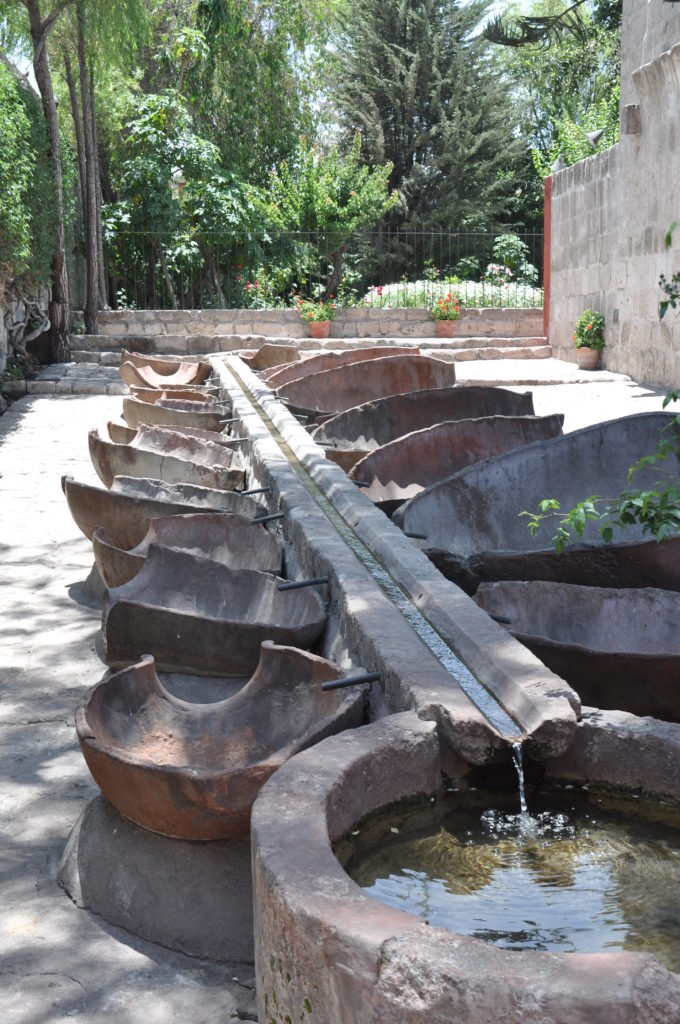
Convent Laundry and Acquaduct for washing.
Simple corks were used to fill and empty these jars with water to wash clothes. At the end of the jars is the connection to the underground canal that empties the dirty water into the Arequipa river.
Brilliant idea. Although grape stomping in the jars and catching the wine at the bottom into vats also seemed like a good idea!
A church with a view
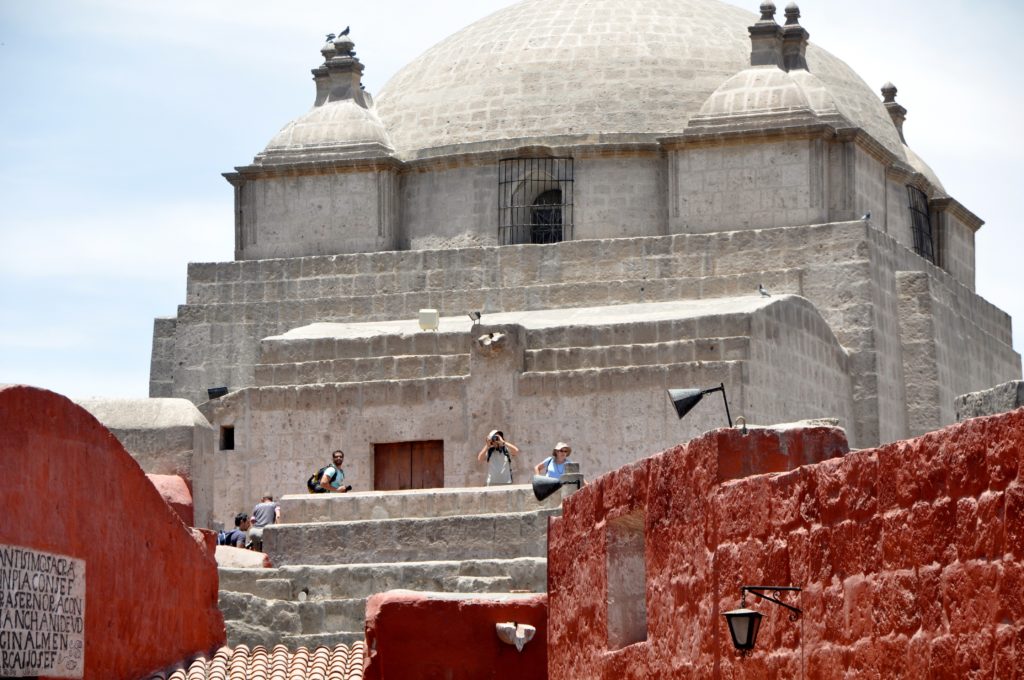
Church with a view – Saint Catalina Monastery.
Our last stop was to climb the wall of the church and take in the spectacular views over the monastery, the city beyond and the beautiful snowy mountains. The view included El Misti – an active volcano (2,380m) that many intrepid trekkers frequently attempt to summit.
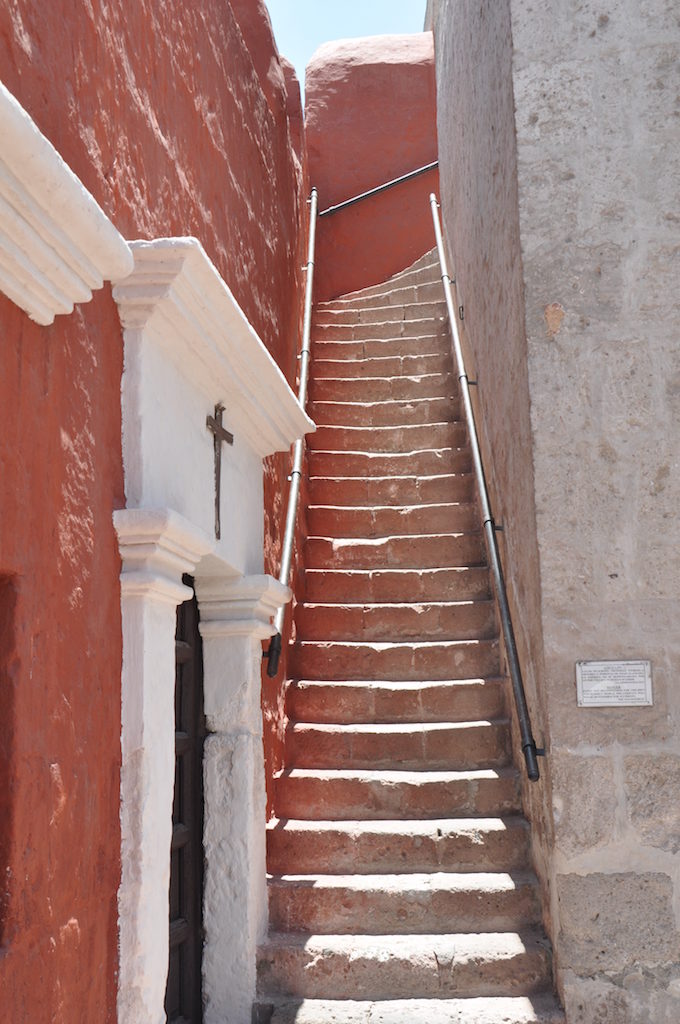
Stairway to heaven and a fabulous view of the mountains.

Mountain views from the top of the Church
Did you know how this elite group of nuns came to be?
The Santa Catalina Monastery only accepted women from upper class families and, at its busiest, the monastery housed 450 people (approximately 1/3 nuns and the rest servants).
This was considered an exclusive “club” with only daughters of rich Spanish families allowed entry. The dowry paid to enter the monastery (where nuns remained for the rest of their lives) was the equivalent of $65,000 AUD.
Now rumour has it that even though the young ladies were supposed to live in poverty and renounce the material world, the rules weren’t enforced. The nuns wouldn’t exactly have run riot but they were able to invite musicians behind the walls, have parties and generally live the lifestyle to which they were accustomed.
But… all good things come to an end and after 3 centuries of enjoyable life at the monastery, the Vatican heard about the luxurious and pampered lifestyle of the nuns and didn’t approve.
So, in 1871, Pope Pius IX sent a devout Dominican nun, to reform the order. All dowries were returned, servants and slaves freed to either leave the monastery or remain as nuns. This meant the monastery was again put back on a strict path to austerity, prayer and fasting and no contact with the outside world.
With these changes the number of nuns declined and funds ran short. But life always goes on and in 1970 the Mayor of Arequipa ordered the Monastery to be connected to running water and electricity. This meant the nuns were forced to open the doors to the outside world to raise revenue for the modern refurbishments.
There you have it…the history of the nuns at the Santa Catalina Monastery.
Entry Fee & Hours:
- Regular Schedule: From 9:00 A.M to 5:00 P.M
- High Season: From 8:00 A.M to 5:00 P.M
- Tuesday to Thursday: From 8:00 A.M. to 8:00 P.M.
- Entrance Fee: 35 Peruvian Soles or $14 AUD
- Plus Guided Tour: 20 Peruvian Soles, approximately $8 AUD
Contact information:
- http://www.santacatalina.org.pe/
- informes@santacatalina.org.pe
- Phone: 51-54-221213
- Fax: 054-281335
Gypsy Tips
- Take local currency for entrance fees, coffee and souvenirs (there is a gift shop)
- Avoid leaning on the walls as the pigments can stick to your clothes.
- Make sure the monastery isn’t closed for religious ceremonies. (Call ahead if unsure)
- Be strong, otherwise you’ll want to sign up to live at the Monastery.
- No need to cover shoulders or knees to enter the monastery
NB – If you know of anyone visiting Peru why not share this blog with them to make sure they don’t miss out on the Saint Catalina Monastery.

Wow! What a fascinating place – I particularly liked the laundry!! But all the RED does it for me as well!! Great to find your blog 😀
Your website is totally amazing! I can’t wait to read it more in depth. I’m guessing you’ve driven over the Big Red sandhill outside Birdsville? What an amazing place that is.